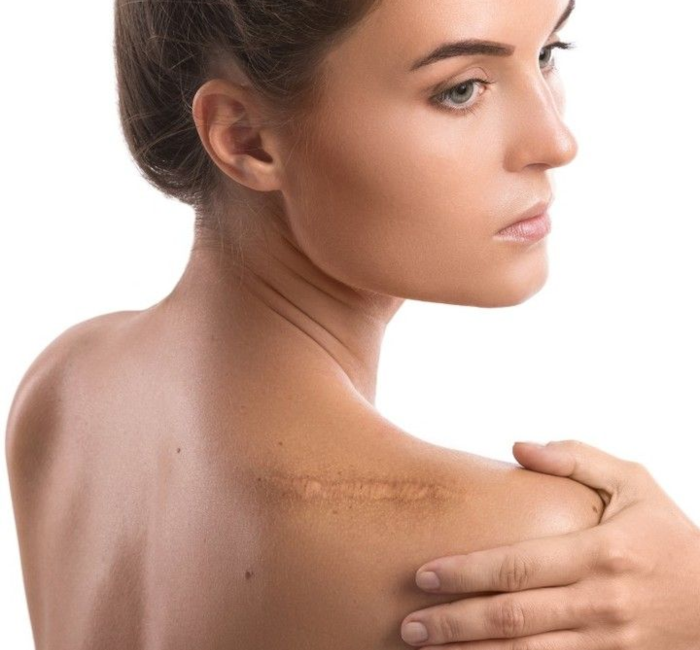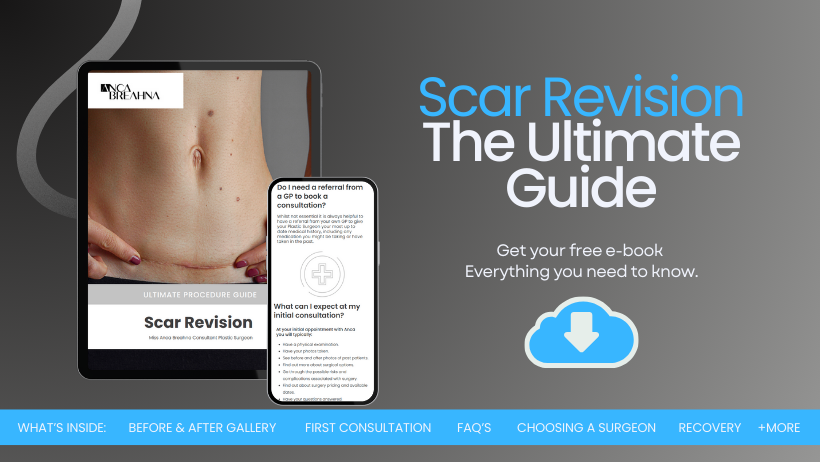Procedures
Scar Revision Surgery UK

Scars, the permanent marks that remain after the skin has healed from an injury, can be a cause of concern for many. Whether they arise from accidental injuries, surgical interventions, or burns, scars might affect your appearance and how you feel about your look. Scar revision surgery aims to reduce the visibility of these marks, enhancing the appearance of the skin and, in some cases, improving functionality when scars restrict movement.
This surgery is not about completely removing the scar, which is a common misconception, but rather about improving its appearance so that it blends more seamlessly with the surrounding skin. The techniques used can vary widely depending on the nature and severity of the scar, as well as your individual skin type and the desired outcome. The main aim here is to make the scar less noticeable, thereby improving your appearance.
Download Miss Anca Breahna’s Scar Revision Guide

At a glance
Depends on the type of procedure perfomed
Local or general anaesthesia
Varies based on the intensity and type of procedure
One time.
Table of Contents
What is Scar Revision Surgery?
Scar revision surgery is a specialised procedure designed to improve the condition and appearance of scars across the body. Unlike other cosmetic procedures that may focus on broader aesthetic goals, scar revision surgery targets specific areas of scarred skin to make these less obvious and to integrate them better with the surrounding skin’s appearance and texture.
The procedure requires a tailored approach that considers the type of scar, its location, the skin type of the patient, and the overall health of the skin surrounding the scar. For example, some scars may only require minor surface treatments such as laser therapy or microdermabrasion, while others may need invasive surgical interventions to alter the scar’s size or orientation.
Anca typically uses a combination of surgical and non-surgical techniques. These can include laser treatment to reduce redness and improve skin texture, surgical excision to remove or alter the scar tissue, and even grafting procedures in more severe cases where large areas of skin are affected.
Who Needs Scar Revision Surgery?
Scar revision surgery is suitable for anyone who feels uncomfortable about the appearance of their scars and is looking for a way to make them less noticeable. However, ideal candidates for this surgery are those who have fully healed scars that are not prone to acne or other skin conditions in the affected area.
The suitability of a candidate for scar revision surgery also depends on the type of scar. Some scars, such as keloids, which are thick, puckered, itchy clusters of scar tissue that grow beyond the edges of the wound or incision, or hypertrophic scars, which are red and raised, can often be improved significantly with surgery. Scars resulting from burns or other traumatic injuries that have led to significant surface irregularities might also make a person a good candidate for this procedure.
Before you consider surgery, it’s important to have a consultation with Anca. During this consultation, Anca will evaluate the scar’s characteristics—such as its size, shape, and depth—as well as your overall skin health and medical history. This is important to determine the most effective treatment plan.
Aside from the physical considerations, it’s important that you have realistic expectations about what the surgery can achieve. While significant improvements are often possible, scars cannot be removed completely. The surgery aims to make scars less noticeable and improve the aesthetic harmony of your skin. This can lead to an enhancement in how you view your appearance and often, an increased level of comfort in social or professional settings.
Benefits of the Scar Revision Surgery Procedure
Undergoing scar revision surgery can offer significant advantages, ranging from aesthetic enhancements to functional improvements. The primary benefit, and often the main motivator for patients considering this procedure, is the improved appearance of the scar. This is achieved through various techniques that aim to reduce the prominence of the scar, making it blend more seamlessly with the surrounding skin.
Aesthetic Improvement
One of the most compelling benefits of scar revision surgery is the improvement in the appearance of scars. Techniques such as laser therapy, microdermabrasion, and surgical excision are designed to make scars less noticeable. This can mean flattening raised scars, smoothing pitted scars, or lightening discolouration. For many people, these changes can make a significant difference in how they feel about their appearance and how they present themselves in social and professional situations.
Functional Improvement
Scars, especially those that are tight or large, can sometimes create physical discomfort or even pain. They may also restrict normal movement, particularly if they are located near joints or on the face. Scar revision procedures can help alleviate these issues. By surgically releasing or repositioning scar tissue, surgeons can enhance mobility and reduce discomfort associated with tight scars.
Psychological and Emotional Benefits
The psychological and emotional benefits of scar revision surgery can be profound. Scars that are a result of traumatic injuries or medical treatments can often serve as unwanted reminders of those events. Improving the appearance of such scars can help individuals move past their trauma, leading to an improved mental state and increased personal confidence in their appearance.
Enhanced Skin Health
In some cases, scar revision can improve the overall health of the skin. Techniques used in the process, like laser treatments, can stimulate new skin growth and promote better skin texture and elasticity. This not only helps the treated area but can also have a positive effect on the surrounding skin.
Types of Scar Revision Procedures
Topical Treatments
These are often used for less severe scars and include over-the-counter or prescription creams, gels, and ointments that can help reduce the size, colour, and texture of scars over time. Silicone sheets or gels are particularly popular for their ability to flatten and fade hypertrophic scars and keloids.
Injectable Treatments
For scars that cause depressions or pits in the skin, fillers can be injected to raise the level of the skin, making the surface smoother. This method is generally temporary, as fillers degrade over time and procedures may need to be repeated to maintain the effect.
Surface Treatments
This category includes methods like laser therapy, microdermabrasion, and chemical peels, which remove the outer layers of skin to encourage new, healthier skin to grow. These treatments can be very effective in improving the texture and appearance of scars, although they may require multiple sessions.
Surgical Revision
This involves cutting out the old scar and repositioning or closing the skin in a way that will likely lead to a less noticeable scar once healed. It may be combined with other techniques, such as skin grafts (transferring skin from another area of the body) or flap surgery (moving skin along with its underlying fat, blood vessels, and sometimes muscle from a nearby area to the site of the scar).
How is the Scar Revision Surgery Procedure Performed?
Scar revision surgery can vary greatly depending on the type of scar, the chosen method for revision, and the individual characteristics of your skin.
Surgical Techniques
For more significant scars, surgical removal or adjustment is often necessary. The procedure involves the following steps:
- Anaesthesia: Depending on the complexity of the surgery and the size of the area being treated, local or general anaesthesia is administered.
- Excision: Anca carefully removes the scar tissue. This step may involve the use of precise cutting tools to minimise trauma to surrounding tissues.
- Closure: The skin is then re-aligned or re-positioned. In cases where there is not enough skin to close the wound neatly, a skin graft or a flap of skin from another part of the body may be used.
- Refinement: Finally, the area is refined to ensure the new scar is less noticeable than the old one. This might involve additional techniques such as laser therapy to smooth out the skin and reduce redness.
Non-Surgical Techniques
Non-surgical methods are less invasive and involve less recovery time. These include:
- Laser Therapy: This uses focused light to treat scar tissue. It can reduce the scar’s redness and smooth out its surface without cutting into the skin.
- Injections: Certain types of scars, particularly those that are thickened, may benefit from injections of corticosteroids or other materials that help flatten and soften the scar.
- Surface Treatments: Dermabrasion and chemical peels are procedures that remove the top layers of skin, which can help reduce the roughness or elevated nature of scars.
Each technique has its indications based on the scar type and desired outcomes, and often, a combination of these methods yields the best results.
Scar revision includes a variety of procedures, each suited to address specific types of scars and patient needs. The choice of procedure will largely depend on the scar’s characteristics—its size, shape, depth, and location—as well as the desired outcome.
Recovery after Scar Revision Surgery Procedure
Recovery from scar revision surgery varies based on the intensity and type of procedure performed. Here’s what you can generally expect:
Post-Surgical Care
- Immediate Care: Immediately following surgery, you may have dressings or bandages applied to your wounds, and in some cases, you might need to stay overnight in the hospital.
- Home Recovery: Once home, it’s important to keep the surgical site clean and protected from any strain. Follow Anca’s instructions on how to care for your wound, when to change bandages, and how to recognise signs of infection.
- Pain Management: Some discomfort is normal after scar revision surgery, and Anca will likely prescribe or recommend pain relief medications.
- Follow-Up Visits: You will need to attend follow-up appointments to monitor your healing and address any concerns.
Healing Time
- Minor Procedures: Non-surgical treatments like laser therapy or injections might have minimal downtime, with patients returning to normal activities almost immediately.
- Major Surgery: For more extensive surgical revisions, the initial healing phase can last several weeks, during which strenuous activities should be avoided.
- Long-Term Care: Even after the wound has healed, the new scar will continue to mature and improve in appearance for up to a year or more. During this time, protecting the scar from the sun is important to prevent darkening and promote optimal healing.
How Much is Scar Revision Surgery in the UK?
The cost of scar revision surgery in the UK can vary widely. Here are some considerations:
- Consultation Fees: Most surgeons charge a consultation fee.
- Type of Procedure: Simple procedures like topical treatments or minor laser sessions can cost a few hundred pounds, whereas extensive surgical revisions can cost several thousand pounds.
- Additional Costs: Remember to account for any aftercare necessities, such as prescription medications, follow-up visits, and possibly corrective treatments.
Cost of Surgery Guide

Further Reading
- Read Anca’s Blog on Treating, Reducing and Minimising Plastic Surgery Scars
- Read Anca’s Blog on How to Get Rid of Old Scars
- Read Anca’s Blog on The Complete Guide to Breast Implant Scars and How to Minimise Them

Procedure
Frequently asked questions
What are the risks associated with scar revision surgery?
While scar revision surgery is generally safe, like all surgical procedures, it carries some risks. These can include infection, bleeding, and an adverse reaction to anaesthesia. There is also the possibility of the scar not improving as expected, or even worsening in appearance due to factors like poor healing or the development of new scar tissue. Discussing these risks with Anca beforehand will help you understand the specific risks associated with your chosen procedure.
Can scar revision surgery completely remove my scar?
It’s important to understand that scar revision surgery does not completely remove a scar but rather improves its appearance, making it less noticeable. The effectiveness of the surgery will depend on various factors, including the size, age, and depth of the scar, as well as individual healing processes.
How should I prepare for scar revision surgery?
Preparation for scar revision surgery involves following your surgeon’s instructions closely. This may include avoiding smoking, not taking certain medications that can affect blood clotting, and fasting for a specific period before the surgery. Anca might also advise you to keep the area clean and free of any cosmetic products.
Is there an ideal time after scarring to pursue scar revision surgery?
The best time to pursue scar revision surgery generally depends on the scar itself. It is usually recommended to wait until the scar matures, which can take anywhere from several months to a year. Mature scars are stable and lighter in colour, which makes them easier to treat and predictably responsive to surgical intervention.
Medical References about Scar Revision Surgery
- Scar Revision – Australian Society of Plastic Surgeons
- Scar Revision – American Society of Plastic Surgeons
- Scar Revision: What It Is, Who Is a Candidate – Cleveland Clinic
- Surgical Scar Revision: An Overview – NCBI
- Scar Treatments: Types of Scars and Their Treatments – WebMD
 Ms Anca Breahna, PhD, MSc, FEBOPRAS, FRCS (Plast) is a highly regarded Consultant Plastic Surgeon specialising in the field of Aesthetic and Reconstructive Plastic Surgery. Anca performs a range of
Ms Anca Breahna, PhD, MSc, FEBOPRAS, FRCS (Plast) is a highly regarded Consultant Plastic Surgeon specialising in the field of Aesthetic and Reconstructive Plastic Surgery. Anca performs a range of 